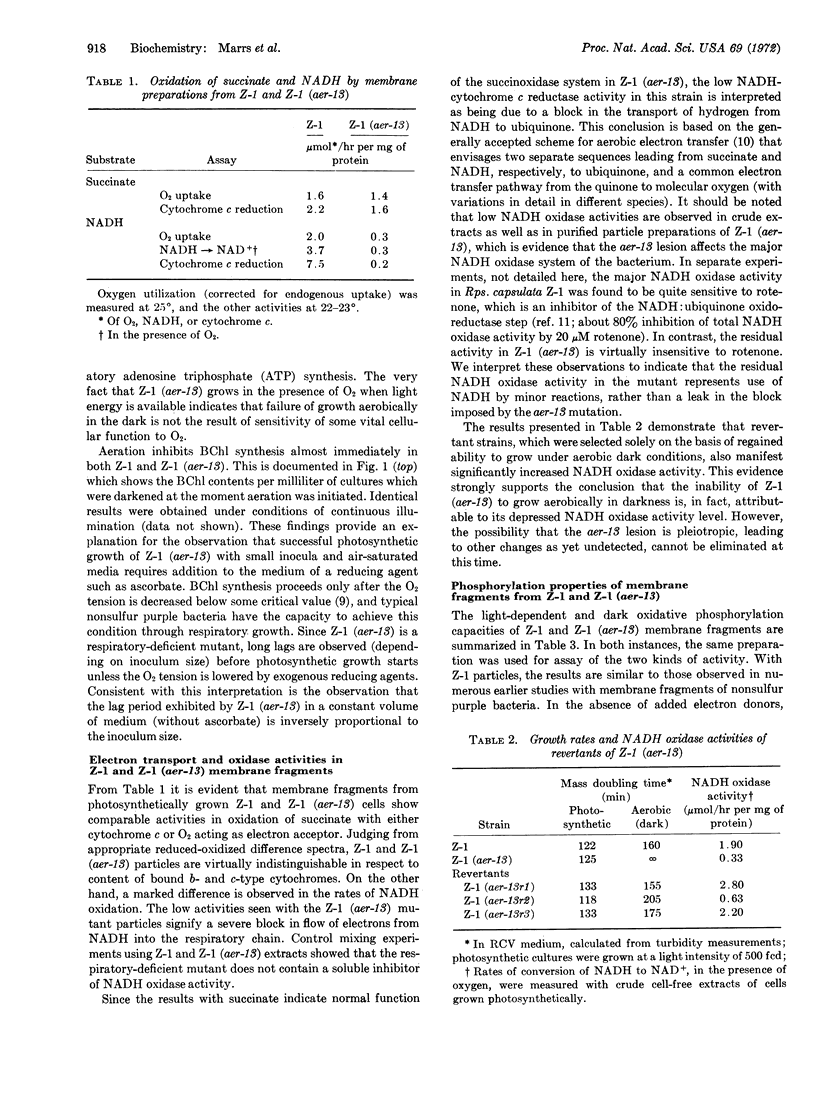Abstract
Nonsulfur purple photosynthetic bacteria generally possess the adaptive capacity to grow anaerobically (photosynthetically) and aerobically in darkness (energy obtained by respiratory phosphorylation). To develop a test system for study of interactions between the photosynthetic energy-conversion and dark respiration systems and the mechanism by which O2 inhibits bacteriochlorophyll synthesis, we have isolated a mutant of Rhodopseudomonas capsulata that is incapable of dark aerobic growth. Both the parent strain and the mutant strain Z-1 (aer-13) grow readily anaerobically in the light with either malate or succinate as the source of carbon and reducing power. They differ, however, in that membrane fragments (“chromatophores”) from the mutant show severely impaired ability to use reduced nicotinamideadenine dinucleotide (NADH) as a source of electrons for respiration, oxidative phosphorylation, or “redox buffering” of the photophosphorylation system. The results presented indicate that the genetic lesion responsible for greatly diminished capacity to oxidize NADH can account for inability of Rps. capsulata Z-1 (aer-13) to grow aerobically in darkness.
Keywords: bacteriochlorophyll, anaerobic growth, dark aerobic growth, photophosphorylation system
Full text
PDF




Selected References
These references are in PubMed. This may not be the complete list of references from this article.
- BOSE S. K., GEST H. Bacterial photophosphorylation: regulation by redox balance. Proc Natl Acad Sci U S A. 1963 Mar 15;49:337–345. doi: 10.1073/pnas.49.3.337. [DOI] [PMC free article] [PubMed] [Google Scholar]
- Baccarini-Melandri A., Gest H., Pietro A. S. A coupling factor in bacterial photophosphorylation. J Biol Chem. 1970 Mar 10;245(5):1224–1226. [PubMed] [Google Scholar]
- COHEN-BAZIRE G., SISTROM W. R., STANIER R. Y. Kinetic studies of pigment synthesis by non-sulfur purple bacteria. J Cell Physiol. 1957 Feb;49(1):25–68. doi: 10.1002/jcp.1030490104. [DOI] [PubMed] [Google Scholar]
- GELLER D. M., LIPMANN F. Photophosphorylation in extracts of Rhodospirillum rubrum. J Biol Chem. 1960 Aug;235:2478–2484. [PubMed] [Google Scholar]
- Gest H. Comparative biochemistry of photosynthetic processes. Nature. 1966 Feb 26;209(5026):879–882. doi: 10.1038/209879a0. [DOI] [PubMed] [Google Scholar]
- HORIO T., KAMEN M. D. Optimal oxidation-reduction potentials and endogenous co-factors in bacterial photophosphorylation. Biochemistry. 1962 Jan;1:144–153. doi: 10.1021/bi00907a022. [DOI] [PubMed] [Google Scholar]
- LOWRY O. H., ROSEBROUGH N. J., FARR A. L., RANDALL R. J. Protein measurement with the Folin phenol reagent. J Biol Chem. 1951 Nov;193(1):265–275. [PubMed] [Google Scholar]
- Lascelles J., Wertlieb D. Mutant strains of Rhodopseudomonas spheroides which form photosynthetic pigments aerobically in the dark. Growth characteristics and enzymic activities. Biochim Biophys Acta. 1971 Mar 2;226(2):328–340. doi: 10.1016/0005-2728(71)90100-9. [DOI] [PubMed] [Google Scholar]
- Lien S., San Pietro A., Gest H. Mutational and physiological enhancement of photosynthetic energy conversion in Rhodopseudomonas capsulata. Proc Natl Acad Sci U S A. 1971 Aug;68(8):1912–1915. doi: 10.1073/pnas.68.8.1912. [DOI] [PMC free article] [PubMed] [Google Scholar]
- Melandri B. A., Baccarini-Melandri A., San Pietro A., Gest H. Interchangeability of phosphorylation coupling factors in photosynthetic and respiratory energy conversion. Science. 1971 Oct 29;174(4008):514–516. doi: 10.1126/science.174.4008.514. [DOI] [PubMed] [Google Scholar]
- ORMEROD J. G., ORMEROD K. S., GEST H. Light-dependent utilization of organic compounds and photoproduction of molecular hydrogen by photosynthetic bacteria; relationships with nitrogen metabolism. Arch Biochem Biophys. 1961 Sep;94:449–463. doi: 10.1016/0003-9861(61)90073-x. [DOI] [PubMed] [Google Scholar]
- Singer T. P., Gutman M. The DPNH dehydrogenase of the mitochondrial respiratory chain. Adv Enzymol Relat Areas Mol Biol. 1971;34:79–153. doi: 10.1002/9780470122792.ch3. [DOI] [PubMed] [Google Scholar]
- Sojka G. A., Freeze H. H., Gest H. Quantitative estimation of bacteriochlorophyll in situ. Arch Biochem Biophys. 1970 Feb;136(2):578–580. doi: 10.1016/0003-9861(70)90231-6. [DOI] [PubMed] [Google Scholar]
- Wittenberg T., Sistrom W. R. Mutant of rhodopseudomonas spheroides unable to grow aerobically. J Bacteriol. 1971 Jun;106(3):732–738. doi: 10.1128/jb.106.3.732-738.1971. [DOI] [PMC free article] [PubMed] [Google Scholar]
- Yonetani T. Studies on cytochrome c peroxidase. II. Stoichiometry between enzyme, H2O2, and ferrocytochrome c and enzymic determination of extinction coefficients of cytochrome c. J Biol Chem. 1965 Nov;240(11):4509–4514. [PubMed] [Google Scholar]
- Zilinsky J. W., Sojka G. A., Gest H. Energy charge regulation in photosynthetic bacteria. Biochem Biophys Res Commun. 1971 Mar 5;42(5):955–961. doi: 10.1016/0006-291x(71)90523-7. [DOI] [PubMed] [Google Scholar]


